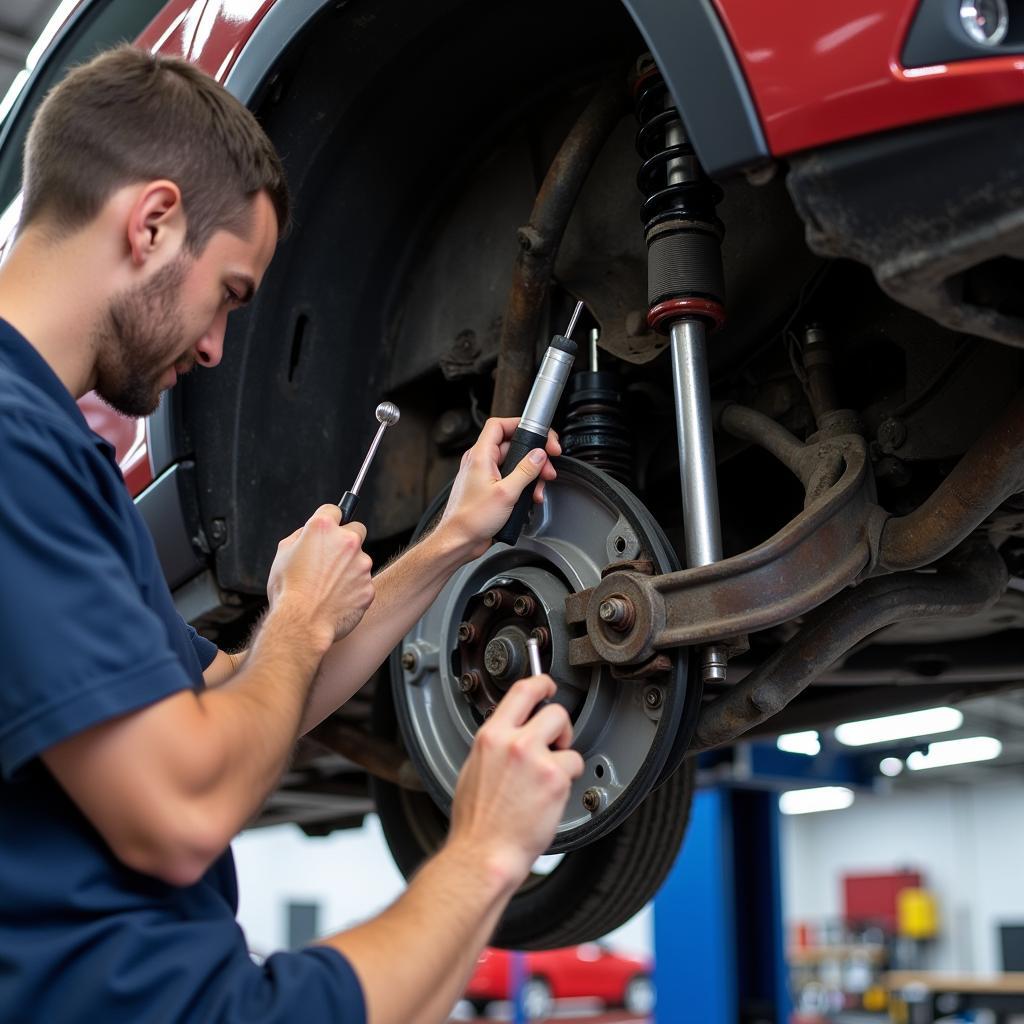Fixing The Suspension Of A Car is crucial for a smooth and safe ride. This guide will delve into the intricacies of car suspension repair, offering valuable insights for car owners, mechanics, and automotive technicians. From diagnosing problems to implementing effective solutions, we’ll cover everything you need to know. After reading this, you’ll be well-equipped to handle suspension issues like a pro. Learn how much it costs to fix a car suspension from our article on average cost of fixing a car suspension.
Understanding Your Car’s Suspension System
The suspension system is a complex network of components designed to absorb shocks from the road, maintain tire contact, and provide stability while driving. It comprises various parts, including shocks, struts, springs, control arms, and bushings. Each element plays a vital role in ensuring a comfortable and controlled driving experience.
Common Signs of Suspension Problems
Recognizing the signs of a failing suspension system is paramount for timely repairs. These signs may include a bumpy ride, excessive bouncing, nose-diving during braking, squeaking or clunking noises, uneven tire wear, and pulling to one side while driving.
 Diagnosing Car Suspension Problems
Diagnosing Car Suspension Problems
Diagnosing Suspension Issues
Diagnosing suspension problems requires a systematic approach. Begin by visually inspecting the components for signs of wear, damage, or leaks. Check the shocks and struts for fluid leaks or damage to the seals. Inspect the springs for cracks or sagging. Examine the control arms and bushings for wear and tear or looseness. A thorough inspection is essential to accurately pinpoint the source of the problem. If you need help with a disconnected wheel, check out how to fix a car that lost its wheel connection.
Testing Your Suspension
Besides visual inspection, conducting a bounce test can help determine the condition of your shocks and struts. Push down firmly on each corner of the car and observe how it rebounds. If the car bounces excessively or continues to oscillate after you release it, it indicates worn shocks or struts.
Fixing the Suspension: DIY vs. Professional Repair
While some minor suspension repairs can be tackled by DIY enthusiasts, more complex issues require the expertise of a qualified mechanic. Replacing worn shocks or struts might be manageable for a DIYer, but tasks like replacing control arms or ball joints are best left to professionals. They have the necessary tools and experience to ensure a safe and effective repair.
“A well-maintained suspension system is not just about comfort, it’s about safety. Don’t compromise on that,” advises John Davis, a veteran automotive engineer with over 20 years of experience.
Choosing the Right Parts
When replacing suspension components, opt for high-quality parts from reputable manufacturers. Using inferior parts can compromise performance and safety. It’s always advisable to consult with a qualified mechanic to ensure you’re choosing the right parts for your specific vehicle make and model. While it might be tempting to go the cheap route, remember that quality parts are a worthwhile investment in the long run. You can learn from the mistakes of others by checking out this funny meme about how not to fix a car meme.
Preventing Future Suspension Problems
Regular maintenance is key to preventing future suspension issues. This includes routine inspections, lubricating moving parts, and addressing minor problems promptly before they escalate. Driving cautiously on rough roads and avoiding potholes can also help extend the life of your suspension components.
“Prevention is always better than cure,” says Sarah Miller, a certified mechanic with a passion for educating car owners. “Regular checks can save you from costly repairs down the line.” Knowing where to start fixing your car can be a challenge. Check out this helpful article about car to fix from.
Conclusion: Keeping Your Car’s Suspension in Top Shape
Fixing the suspension of a car is essential for a safe and enjoyable driving experience. By understanding the components, recognizing the signs of problems, and implementing effective solutions, you can keep your car’s suspension in top shape. Remember, regular maintenance and timely repairs are crucial for preventing future issues and ensuring a smooth, comfortable ride. Need assistance? Connect with us at AutoTipPro for personalized support. Call us at +1 (641) 206-8880 or visit our office at 500 N St Mary’s St, San Antonio, TX 78205, United States.




Leave a Reply